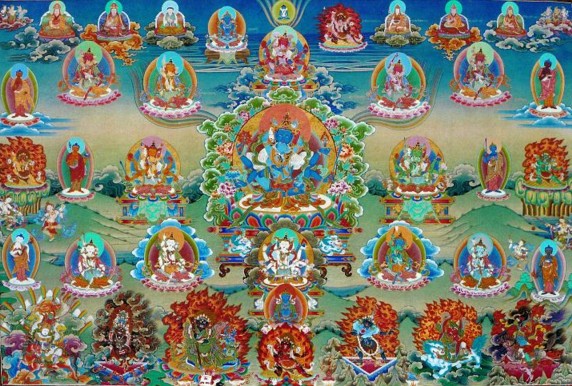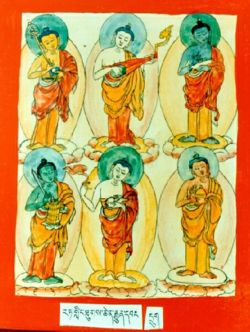Forty-two peaceful deities: Difference between revisions
(→2) Samantabadri: Tibetan listed in main entry.) |
|||
| (11 intermediate revisions by 3 users not shown) | |||
| Line 1: | Line 1: | ||
[[Image:Peaceful guhyagarbha.JPG|frame|'''Peaceful Deities from the Mandala of Hundred Peaceful and Wrathful Deities''']]The '''forty-two peaceful deities''' (Tib. ''shyiwé lha shyé nyi''; [[Wyl.]] ''zhi ba'i lha zhe gnyis'') belong to the mandala of the [[Hundred Peaceful and Wrathful Deities]], and feature in several practices and cycles of teachings, most notably the ''[[Tibetan Book of the Dead]]'' and the [[Guhyagarbha Tantra]]. They are: | <noinclude>[[Image:Peaceful guhyagarbha.JPG|frame|'''Peaceful Deities from the Mandala of Hundred Peaceful and Wrathful Deities''']]</noinclude>The '''forty-two peaceful deities''' (Tib. ཞི་བའི་ལྷ་ཞེ་གཉིས་, ''shyiwé lha shyé nyi''; [[Wyl.]] ''zhi ba'i lha zhe gnyis'')<noinclude> belong to the mandala of the [[Hundred Peaceful and Wrathful Deities]], and feature in several practices and cycles of teachings, most notably the ''[[Tibetan Book of the Dead]]'' and the [[Guhyagarbha Tantra]]. They </noinclude> are: | ||
1) [[Samantabhadra]] | ====1) Samantabadra==== | ||
[[Samantabhadra]] | |||
These deities are also described as the [[deities of the three seats]]. | ====2) Samantabadri==== | ||
[[Samantabhadri]] | |||
====3-7) The Five Male Buddhas of the Five Families==== | |||
{{:buddhas of the five families}}<br> | |||
====8-12) The Five Female Buddhas of the Five Families==== | |||
{{:five female buddhas}}<br> | |||
====13-20) The Eight Male Bodhisattvas==== | |||
{{:eight great bodhisattvas}} | |||
[[eight great bodhisattvas|Read more]] about them<br> | |||
====21-28) The Eight Female Bodhisattvas==== | |||
{{:eight female bodhisattvas}}<br> | |||
====29-34) The Six Munis==== | |||
{{:six munis}}<br> | |||
====35-38) The Four Male Gate Keepers==== | |||
{{:four male gate keepers}}<br> | |||
====39-42) The Four Female Gate Keepers==== | |||
{{:four female gate keepers}} | |||
<noinclude>These deities are also described as the [[deities of the three seats]]. | |||
==Further Reading== | |||
*[[Thinley Norbu]], ''The Small Golden Key'' (Shambhala Publications, 1999), pages 72-81. | |||
[[Category:Buddhas and Deities]] | [[Category:Buddhas and Deities]] | ||
[[Category:Hundred Peaceful and Wrathful Deities]] | [[Category:Hundred Peaceful and Wrathful Deities]] | ||
[[Category:Enumerations]] | |||
[[Category:40s-Forties]]</noinclude> | |||
Latest revision as of 18:45, 19 June 2018

The forty-two peaceful deities (Tib. ཞི་བའི་ལྷ་ཞེ་གཉིས་, shyiwé lha shyé nyi; Wyl. zhi ba'i lha zhe gnyis) belong to the mandala of the Hundred Peaceful and Wrathful Deities, and feature in several practices and cycles of teachings, most notably the Tibetan Book of the Dead and the Guhyagarbha Tantra. They are:
1) Samantabadra
2) Samantabadri
3-7) The Five Male Buddhas of the Five Families
Buddhas of the five families (Skt. jinakula; Tib. རྒྱལ་བ་རིགས་ལྔ་, Wyl. rgyal ba rigs lnga) — the five peaceful buddhas of the sambhogakaya:
- Vairochana, buddha family
- Akshobhya, vajra family
- Ratnasambhava, ratna family
- Amitabha, padma family
- Amoghasiddhi, karma family
8-12) The Five Female Buddhas of the Five Families
The five female buddhas of the five families, also known as the five mothers (Tib. ཡུམ་ལྔ་, Wyl. yum lnga) are:
- Dhatvishvari also known as Vajra Datvishvari or White Tara, the consort of Vairochana, who represents the purity of the element space
- Buddhalochana the consort of Akshobhya, who represents the purity of the element earth
- Mamaki the consort of Ratnasambhava, who represents the purity of the element water
- Pandaravasini the consort of Amitabha, who represents the purity of the element fire
- Samayatara also known as Green Tara, the consort of Amoghasiddhi, who represents the purity of the element wind
13-20) The Eight Male Bodhisattvas
Eight Great Bodhisattvas, or 'Eight Close Sons' (Skt. aṣṭa utaputra; Tib. ཉེ་བའི་སྲས་བརྒྱད་, nyewé sé gyé, Wyl. nye ba'i sras brgyad) — the main bodhisattvas in the retinue of Buddha Shakyamuni:
| This section contains Tibetan script. Without proper Tibetan rendering support configured, you may see other symbols instead of Tibetan script. |
- Mañjushri
- Avalokiteshvara
- Vajrapani
- Maitreya
- Kshitigarbha
- Akashagarbha
- Sarvanivaranavishkambhin
- Samantabhadra
Read more about them
21-28) The Eight Female Bodhisattvas
The eight female bodhisattvas (Tib. བྱང་ཆུབ་སེམས་མ་བརྒྱད་, changchub semma gyé, Wyl. byang chub sems ma brgyad) are also referred to as the eight offering goddesses. They are the consorts of the eight great bodhisattvas:
- Goddess of Beauty (Skt. Lāsyā; Tib. Gekpama; Wyl. sgeg pa ma) the consort of Kshitigarbha
- Goddess of Garlands (Skt. Mālā; Tib. Trengwama; Wyl. phreng ba ma) the consort of Akashagarbha
- Goddess of Song (Skt. Gītā; Tib. Luma; Wyl. glu ma) the consort of Vajrapani
- Goddess of Dance (Skt. Nṛtyā; Tib. Garma; Wyl. gar ma) the consort of Avalokiteshvara
- Goddess of Flowers (Skt. Puṣpā; Tib. Metokma Wyl. me tog ma) the consort of Sarvanivaranavishkambhin
- Goddess of Incense (Skt. Dhūpā; Tib. Dukpöma; Wyl. bdug spos ma) the consort of Maitreya
- Goddess of Light (Skt. Ālokā; Tib. Marmema or Nangselma; Wyl. mar me ma) the consort of Samantabhadra
- Goddess of Perfume (Skt. Gandhā; Tib. Drichabma; Wyl. dri chab ma) the consort of Mañjushri
Symbolically they represent the pure state of sense objects.
29-34) The Six Munis

The Six Munis (Skt.; Tib. ཐུབ་པ་དྲུག་, Tubpa Druk, Wyl. thub pa drug) are the supreme nirmanakaya buddhas for each of the six classes of beings. They are:
- Indra Kaushika (Skt. Kauśika; Tib. དབང་པོ་བརྒྱ་བྱིན་ or ལྷའི་དབང་པོ་བརྒྱ་བྱིན་, Wangpo Gyajin, Wyl. dbang po brgya byin) for the god realms
- Vemachitra (Skt. Vemacitra; Tib. ཐགས་བཟང་རིས་ or ཐག་བཟང་རིས་, Taksangri, Wyl. thags bzang ris) for the demi-gods or asura realms
- Shakyamuni (Skt. Śākyamuni; Tib. ཤཱཀྱ་ཐབ་པ་, Wyl. shAkya thub pa) for the human realm
- *Shravasingha, *Dhruvasiṃha or *Siṃhapradyota (Skt.; Tib. སེང་གེ་རབ་བརྟན་, Sengé Rabten, Wyl. seng ge rab brtan) for the animal realm
- Jvalamukhadeva (Skt. Jvālāmukhadeva; Tib. ཁ་འབར་དེ་བ་, Khabar Dewa, Wyl. kha ‘bar de ba) for the preta realms
- Dharmaraja (Skt. Dharmarāja; Tib. ཆོས་ཀྱི་རྒྱལ་པོ་, Chökyi Gyalpo, Wyl. chos kyi rgyal po) for the hell realms
35-38) The Four Male Gate Keepers
The four male gatekeepers (Tib. སྒོ་བ་ཡབ་བཞི་, gowa yab shyi, Wyl. sgo ba yab bzhi) are:
- Achala, guarding the east gate (or Vijaya, or Mahabala?)
- Yamantaka, guarding the south gate
- Hayagriva, guarding the west gate
- Amritakundali, guarding the north gate
39-42) The Four Female Gate Keepers
The four female gatekeepers (Tib. སྒོ་མ་བཞི་, go ma shyi, Wyl. sgo ma bzhi) are:
- Ankusha (Skt. Aṅkuśā; Wyl. lcags kyu ma or rta gdong ma) also called 'Horse Face' or 'Iron Hook', guarding the east gate and in union with Vijaya (or Achala?)
- Pasha (Skt. Pāśā; Wyl. zhags pa ma or phag gdong ma) also called 'Sow Face' or 'the Noose', guarding the south gate and in union with Yamantaka
- Shrinkhala (Skt. Śṛṅkhalā; Wyl. lcags sgrog ma or seng gdong ma) also called 'Lion Face' or 'Iron Chain', guarding the west gate and in union with Hayagriva
- Ghanta (Skt. Ghaṇtā; Wyl. dril bu ma or spyang gdong ma) also called 'Wolf Face' or 'the Bell', guarding the north gate and in union with Amritakundali.
These deities are also described as the deities of the three seats.
Further Reading
- Thinley Norbu, The Small Golden Key (Shambhala Publications, 1999), pages 72-81.
